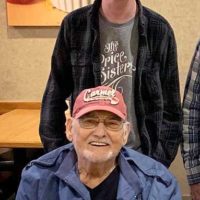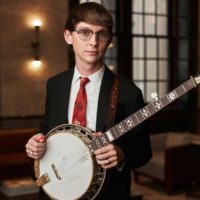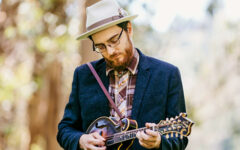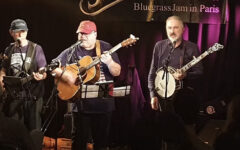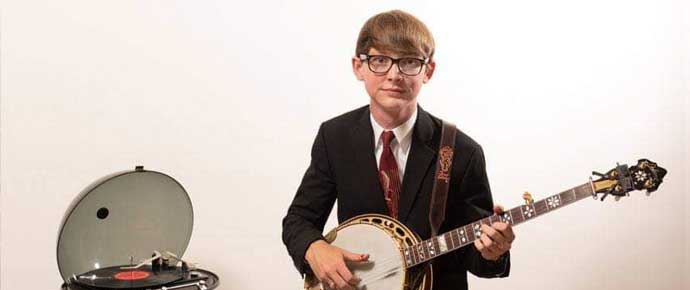
Everyone who has followed bluegrass over the past 70 years should be familiar with the great Sonny Osborne. One half of the legendary Osborne Brothers who revolutionized bluegrass music in the 1950s and ’60s, Sonny played a style of banjo that closely followed the model of his dear friend Earl Scruggs, but branched out in novel ways that were Sonny’s alone.
Sonny also had an outsized personality, even larger than the man who stood on stage for so many years. No one who ever met him is likely to forget the occasion, and Sonny was never scared to speak his mind.
But have you met his protege? Lincoln Hensley of Johnson City, TN, sat down with me during the Hall of Fame ceremonies at the American Banjo Museum, and we chatted about Sonny’s legacy and his love for the five string.
At the age of 14, Lincoln chose the banjo as his point of interest. It seems that his Dad had three instruments lying around, a guitar, a banjo, and a fiddle, and young Hensley felt an almost gravitational pull towards the banjo. Soon after, he began banjo lessons from the local music store. However, the instructor didn’t even play the banjo (or own one for that matter), and in actuality was teaching him from an Earl Scruggs book on a borrowed banjo.
Lincoln delved in and began to read ahead, and on his third lesson, announced it would be his last. However, Hensley did learn the Foggy Mountain Breakdown and a few other licks from local banjoist, Edison Wallin. “That was all on a landline. I would call him after school, and he would teach me over the phone. I would listen to Edison play, then repeat it back to him. I took lessons from Edison for four years. I still learn a lot from him every time we get to play together,” Hensley shared.
Hensley was a regular on the online discussion forum, Banjo Hangout, as was Sonny Osborne. “I would ask Sonny questions and one day, Sonny said, ‘I will teach you the lick, but first you have to get Earl’s record of Foggy Mountain Banjo, the yellow track album. Learn every song, front to back, and every lick, every sound that Earl makes, then I will teach you.’ I practiced that album every day for 6-8 hours.”
Finally, after nine months or so, Lincoln messaged Sonny, “You may not remember me, but you told me to learn Earl’s album, and I learned it.” Sonny replied, “play me the third break of Sally Goodin and send me the video.” Osborne wanted the video in the next 10 minutes. Lincoln did, and it wasn’t long until Sonny took Lincoln under his wing and into his life. At this point, Lincoln was a freshman in college.
Then one day, world renowned banjo picker Kenny Ingram took Lincoln to lunch in Nashville. That day circled around the table were some of the greatest pickers in bluegras: Ronnie Reno, Gary Scruggs, Eddie Stubbs, and SONNY! Osborne said to him, “I just live up the road. Let’s stop this email stuff and you can come to the house. I will show you this stuff in person.”
Hensley felt like Charlie in Willy Wonka and the Chocolate Factory and this was his “golden ticket.” The opportunity of a lifetime, the chance to work hand in hand with his idol, Sonny Osborne.
Sonny and his wife, Judy, relatively private people, welcomed Lincoln into their home with open arms. Monthly, Lincoln would make that four hour drive to the Osbornes and learn, talk, and become a great friend. “Sonny didn’t teach me how to play like him, but to think like a musician,” stated Hensley. Sonny also taught the most valuable lesson to this 24 year old, which was to separate business from friendship.
During the peak of his career, Sonny had an imaginary friend that got all the blame for the mistakes, baubles, bad keys, out of tune playing, etc. He named him Krako. One day when Lincoln was visiting, Sonny had been tinkering in the garage building a banjo out of parts. Then he handed Hensley a banjo and said, “Go try this out and see what you think.”
“Sonny had wanted to cover up the name that was on the ‘part’ used for the neck. So I took duct tape, and placed it over the name on the banjo peghead and wrote Krako in silver sharpie,” Lincoln shared with a twinkle in his eye and a slight laugh. He took it to a gig that night, and it was like someone had waved a magic wand. People were interested in the sound, and wanted to know more about this particular instrument.
Lincoln hurried back to the Osbornes, and told Sonny, “There is a market for these.” That’s how Krako Banjos came into existence. Patterned after Sonny’s 1934 Gibson Granada (9584-2), which was one digit from the serial number on Earl Scurggs’ flat head Granada, the Krako Banjos are made in the USA. In fact Lincoln assembles and fits each one which are set up to Sonny’s standards. At first, Sonny’s signature sat alone on the 15th fret, until one afternoon when Osborne called Lincoln and said, “I need your signature. Write your name on a white sheet of paper and send it to me.” Osborne had a plan, and it was set into action as Sonny took Hensley’s handwritten signature, made it into an inlay, and placed it on the 21st fret.
Looking back, Lincon said that “All Sonny wanted was credit.”
If the day ever comes when Lincoln can’t be hands-on in the production of the Krako, the company will end. Sonny’s concept is still working, “Never spend a dime on advertising.” Krako doesn’t have any endorsements at this time, but testimonials from Lizzy Long and Derek Vaden abound. Mickey Flatt of The Bonhams (Edmond Oklahoma-based band) stated, “From the time I first opened the case on K2, I knew this is the banjo I have been looking for! It’s as close to Sonny’s Granada as I have ever played. If these banjos sound this good new, just think what they will sound like 10-20 years down the road.” While there is currently a two year waiting list, pickers are willing to endure it to get their hands on one of these Krakos.
Sonny Osborne’s life was cut short in October 2021, however, his rich musical legacy remains. And Hensley has a personal legacy to preserve as well. “I have so many tons of notes from Sonny, it will take me years to go through everything,” he said.
Today, Hensley is active with his own group, The Tennessee Bluegrass Band, accompanied by Aynsley Porchak, whom I have dubbed the Queen of the Double Stop in honor of Byron Berline. Porchak is the only winner of both the US and Canadian Grand Master Fiddle Championships. In 2015, Porchak won the title of Grandmaster Fiddle Champion in Tennessee, and a mere two years later was crowned the Canadian Fiddle Champion. “Canadian style fiddling is like speaking a slightly different language,” says Porchak. The TBB has an old sound and sticks to the ways of traditional bluegrass.
In September of 2022, Lincoln Hensley accepted the induction of Sonny Osborne into the Banjo Hall of Fame in Oklahoma City. During his acceptance speech, Hensley shared his life with Rocky Top’s Sonny Osborne. Maybe it was being in the right place at the right time, but I think it was meant for Sonny to shine his light on Hensley, and continue shining it through him.
